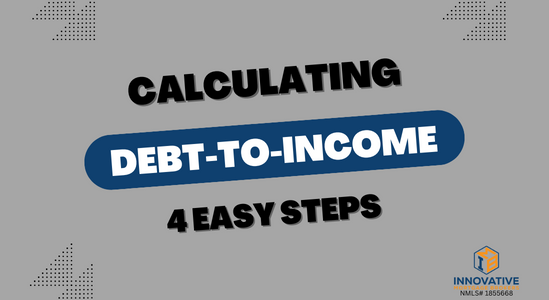FHFA Opens Door to Cryptocurrency in Mortgage Risk Assessments: What It Means for Borrowers and…
Calculating Debt-to-Income Ratio (DTI)
What is Debt-to-Income Ratio (DTI)
Debt-to-Income Ratio, often abbreviated as DTI, is a critical metric used by lenders to determine your ability to repay a loan. It is calculated by dividing your total monthly debt payments by your gross monthly income. This ratio gives lenders a clear picture of your financial health and the risk they might be taking by lending you money.
How is Debt-to-Income Ratio Calculated?
Calculating your Debt-to-Income Ratio (DTI) involves a simple two-step process. However, it’s important to have accurate figures for both your monthly debt obligations and your gross monthly income.
Step 1: Calculate Your Monthly Debt Payments
First, you need to calculate your total monthly debt payments. This includes all recurring debts that you are obligated to pay each month that usually appears on your credit report. Common types of debt that are included are:
- Mortgage or rent payments (if they will continue)
- Minimum credit card payments
- Car loans
- Student loans (even if in deferment or forbearance)
- Personal loans
- Child support or alimony payments
- Any other regular debt payments
Add up all these payments to get your total monthly current debt payments.
Step 2: Add Expected Housing Expenses
If you’re considering taking on a new mortgage, it’s important to include the expected housing expenses in your monthly debt payments (PITI):
- New Mortgage Payment: The principal and interest payment for the new loan you’re considering.
- Property Taxes: These can be included as part of your mortgage payment, but you’ll want to confirm the exact amount with your lender or local tax assessor’s office.
- Homeowners Insurance: This cost varies based on your location, the value of your home, and the coverage level you choose. You can get an estimate from an insurance agent or online quote tool.
- Private Mortgage Insurance (PMI): If your down payment is less than 20% of the home price, you’ll likely have to pay PMI. The cost of PMI varies but is typically between 0.25% and .75% of the entire loan amount annually.
Add these amounts to your total monthly debt payments.
Step 3: Determine Your Gross Monthly Income
Next, you need to determine your gross monthly income. This is your income before taxes and other deductions. It’s crucial to know exactly how to calculate the income because if you are on salary, that’s easy. However, if you are self-employed, or are receiving hourly wages, commission, bonuses, etc. there are program guidelines that need to be followed.
Income could include:
- Wages from your job or self-employment
- Part time employment
- Rental property income
- Social security / disability benefits
- Alimony or child support you receive
- Any other regular source of income
Once you have these two figures above (total monthly expenses and total monthly income), you can calculate your DTI.
Step 4: Calculate Your DTI
To calculate your DTI, divide your total monthly debt payments by your gross monthly income. Then, multiply the result by 100 to get your DTI as a percentage. The formula is:
DTI = (Total monthly debt payments / gross monthly income) x 100
For example, if your total monthly debt payments are $2,000 and your gross monthly income is $6,000, your DTI would be 33%.
The lower your DTI, the less risky you are to lenders. Each lender might have different thresholds for what they consider a “good” DTI, as well as there are different program requirements.
Importance of DTI in Mortgage Lending
DTI is a significant factor when it comes to mortgage lending. A lower DTI indicates a good balance between debt and income, which makes you a less risky borrower in the eyes of lenders. On the other hand, a high DTI may suggest that you are overburdened with debt and might struggle to make your mortgage payments.
Why Work with Innovative Mortgage Brokers
A good loan officer is instrumental in accurately calculating your DTI. They consider all your debts, including student loans, car loans, credit card debts, and any other personal loans. They also consider all your sources of income, ensuring that your DTI is not skewed due to an oversight of any debt or income source or miscalculation. An inaccurate calculation of the debt to income can lead to a denial of a loan application.
At Innovative Mortgage Brokers, our loan officers are well-versed in all aspects of mortgage lending. We understand the nuances of DTI calculation and the implications it has on your loan approval process. We also have access to many lenders and different programs.
Conclusion
The Debt-to-Income Ratio (DTI) is an essential tool that provides a snapshot of your financial health. By comparing your total monthly debt payments to your gross monthly income, lenders can assess your ability to manage and repay debts. A lower DTI ratio is generally more favorable and indicates that you have a good balance between your income and your debts.
Calculating your DTI involves adding up all your monthly debt payments, including any expected housing costs if you’re considering taking on a new mortgage, and dividing this total by your gross monthly income. It’s important to be thorough and accurate when calculating these figures to ensure your DTI ratio is correct.
The DTI ratio plays a key role in mortgage lending. It helps lenders determine whether you’re a reliable borrower and can comfortably afford your mortgage payments. While each lending institution may have different thresholds for what they consider a “good” DTI, keeping your DTI low can improve your chances of securing a loan.
However, remember that while the DTI is an important consideration, it’s not the only factor lenders look at when deciding whether to approve a loan. Your credit score, employment history, and the amount of savings you have are also important.
In conclusion, understanding your DTI and striving to keep it within acceptable limits is an integral part of maintaining a healthy financial state. It can guide you in making informed decisions about taking on additional debt and help you work towards your financial goals.





